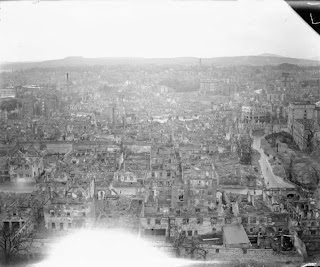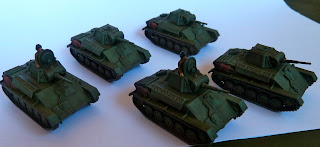One of my pleasant duties as Head of History at school is to speak every year at the Anzac Day Assembly. Although Anzac Day was last week, we only held the assembly today due to holidays. The Assembly is a very special occasion, with Form IV and Cadets attending each year, along with old boys of the school who served. I decided to speak about the involvement of boys from the school in Bomber Command this year. The gentlemen who did the reading had been shot down in a Stirling in 1943, and it was people like him I wanted to pay tribute to. I've put the text of the speech below for anyone who's interested.
The images are from Wikimedia Commons
Bomber Command

In 1942, a young man of 19 stood in his garage in Roseville preparing to go to war. He made a stencil of his name and service number to paint on to his luggage before embarking to England as a member of the Royal Australian Air Force. Perhaps to test his work, or maybe just to leave a trace of himself, he stenciled his name several times on the garage walls. Forty years later as a child I would look at his name and wonder what became of him.
Today I want to pay tribute to the Australian men who took part in the bomber offensive against Germany from 1942-45 as part of the Royal Airforce’s Bomber Command, and particularly to the Old Boys of the School who served. I say men, and that is how they seemed to me as a boy. Growing up in the 1970s and 1980s, WWII still seemed very recent, particularly in the impact it still had on many of the adults in my life. Raised on a steady diet of books about the war, movies like the Dambusters and Airfix models, most of our games, and many of our heroes were drawn from the larger than life figures of the war. I would sit in awe during visits from my honorary uncle whom I knew had taken part in bomber raids as a navigator during the war. He never liked to talk about it. I learned the almost mystical names that evoked that different time - Lancaster, Stirling, Halifax and Wellington – and picked up some notion of German geography from places that had been targets of the Royal Air Force – Berlin, Nuremburg, the Ruhr, Hamburg and Dresden. Uncle Doug and men like him were my Hector and Achilles, their deeds my Iliad. Now, in middle age, I’m amazed by the youth of those who took part in the raids on Germany as part of Bomber Command. They served in squadrons where members over the age of 30 could earn the nickname ‘grandpa’.
Around 10,000 young Australians took part in the bomber offensive. Over 3,000 were killed. I want to speak about them in order that we might not forget, to paraphrase Herodotos, so that time may not draw the colour from their deeds.
70 years ago, as 1943 dawned, Britain and Australia had been at war with Nazi Germany for over three years, with Japan for over a year. The German army was suffering its first crushing setback in the disaster of Stalingrad, but over two more years of brutal warfare lay ahead until the Red Army finally captured Berlin.
Since the fall of France in 1940, it was only in North Africa, at sea and in the air that Britain could maintain the war against Germany, and only in the air could it hope to actually target Germany’s ability to wage war. The intensity of air raids against Germany stepped up during 1943, as Bomber Command effectively opened a second front in the war against Germany. The impact of bombing resulted in a large proportion of German arms production being diverted from the Russian Front to fight the bombers, as well as many fighter squadrons. Bombing in 1943 was inaccurate, with few bombs hitting specific targets such as factories. For the head of Bomber Command, Sir Arthur Harris, the solution was to focus on area targets – cities – in the belief that German civilian morale would crack under the threat of the bombers. He was wrong in this – both German and allied planners underestimated the resilience of civilians under air attack, and the morality of his strategy remains controversial 70 years later. However, as the war went on and Bomber Command, along with the US 8th Air Force, focused their attacks on arms production, transportation and particularly oil production, aerial attacks played a significant role in the final defeat of Germany.

The men called upon to implement these strategies did so in conditions of appalling danger. By 1943 the most common type of aircraft in use was the Avro Lancaster, with a seven-man crew. They waged a very lonely war. Bomber Command generally attacked at night, each aircraft operating independently. In a typical raid over Germany the crewmembers would remain in their positions for 8 or more hours. With the temperature outside the aircraft regularly around -40 degrees, crews wore electrically heated suits that raised the temperature to a more comfortable -20. Frostbite and hypothermia were constant risks. Over occupied Europe and Germany searchlights probed the sky for bombers. Anti-aircraft fire – the ubiquitous flak – could turn an aircraft heavily laden with fuel and explosives into a blazing shambles in seconds. German night fighters posed the most deadly threat, using radar to identify and intercept bombers. Survival against the fighters depended almost entirely on an alert Lancaster gunner spotting the fighter before it was able to open fire, and on the pilot taking violent evasive action. And if these dangers weren’t enough, crews also had to contend with the risk of collision and of being accidentally bombed by one of their own aircraft.

A few statistics highlight the exceptional experience of Bomber Command. Aircrews were required to complete 30 operations over Germany. In 1943 about 1 in 6 aircrew was expected to survive this first tour of duty. Only about 1 in 40 was likely to survive his second. Around half of all airmen in Bomber Command were killed or died of wounds during the war. Of the remainder, over 10% were shot down and captured. Only 2% of Australians who fought during the war joined Bomber Command, but bomber crews comprised about 20% of all Australians killed during the war. Many of those who did survive suffered deep injuries, both physical and psychological.
The story of Bomber Command is very much a part of the School’s story, as a glance at the Honour Board makes clear. It is striking how many names are followed by RAF or RAAF. The vast majority of them died as members of Bomber Command, and their graves are now spread from Cambridge to Berlin and as far as Budapest. Some are buried in Canada and Sydney, victims of training accidents. All of them had families, pasts and futures that were taken from them.
Two of the boys listed on the board were killed on the same night just over 70 years ago, on 20 April 1943. That evening, at about 10pm, 339 aircraft of Bomber Command took off from their bases in England to attack the port of Stettin on the Baltic coast. 21 aircraft were lost. As chance would have it, two of the Lancasters shot down that night included former students from this school in their crews. Flight Sergeant Peter MacKenzie and Flying Officer Guy Herring were both 23 years old.

Peter MacKenzie, from Darling Point, was the bomb aimer in a Lancaster from 460 Squadron, RAAF. 460 Squadron has the distinction of dropping more bombs on Germany during the bomber offensive than any other. It also suffered more casualties than any other squadron. From a complement of about 200 aircrew, it suffered casualties of 1018. In other words, the squadron was wiped out five times during the war. Peter MacKenzie’s aircraft crashed in the Baltic during the night of 20/21 April, probably shot down by a German night fighter. His was the only body from the seven-man crew recovered, and he is now buried in the Commonwealth war graves cemetery in Kiel. It was his first operation.
Guy Herring’s body was never found. The Lancaster from 100 Squadron RAF in which he served as a navigator took off from its base in Lincolnshire just before 10pm on the 20 April. It also disappeared over the Baltic, although the bodies of two of its crew were recovered by the Germans and buried. Guy Herring’s name is listed along with more than 20,000 others on the Runnymede Memorial, just outside London, which lists the aircrew from the British Empire who died during WWII but who have no known grave. He played Rugby in the First XV in his last two years at school, in 1937-8. He was good at History, scoring an A in his Intermediate School Certificate. A fit young man with swept-back hair and holes in his socks gazes out forever from his team photograph in the School magazine of 1938. It is hard to comprehend that he would be lost high above the Baltic within five years.

On Anzac Day words like heroism are often used very lightly, to the point that they can be drained of meaning. I know that many veterans feel uncomfortable when they are bandied about too freely, and for the rest of us, indiscriminate appeals to heroism can breed cynicism. However, we should be proud to describe as heroism the ability of those young men 70 years ago to clamber night after night into their aircraft, knowing that their survival depended almost entirely on luck. It is no wonder that many bomber crews developed elaborate superstitious rituals to try to ward off death, or that they often spent their time off duty living riotously in the moment. What amazes me is that the vast majority found some way to manage the tension and the fear. I don’t know how they did it.
As a young boy, the deeds of these men during the war seemed heroic, and they still do. But what strikes me now is also the everyday heroism that so many who survived have exhibited ever since. Survivors of bomber command often suffered deep scars, physical and emotional. Some have struggled with guilt, both due to the fact they survived and due to the awareness of the suffering they were called on to inflict. The shameful failure of successive governments in the UK and Australia to pay proper tribute to bomber command also left its impact. Bomber Command crews returning to Australia received little official recognition, and indeed were often derided as ‘bludgers’ who had dodged the ‘real war’ in the Pacific. Unbelievably, some were accused of cowardice. Many struggled to readjust to civilian life after the intensity of their wartime experiences.
No medals are ever awarded for the everyday heroism of living well after those experiences, of raising families, doing jobs well and keeping the wheels of civilization and culture turning. Lest we forget.








































